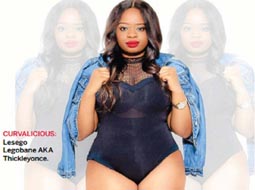 IMG Models, a global modelling agency based in America, recently signed its first "plus size” male model. IMG Models, a global modelling agency based in America, recently signed its first "plus size” male model.
Zach Miko, an actor and former US Target model looks, to my eye, like
most fit young men. Yet Miko is one of very few plus size male models
with agency contracts.
The UK has no plus sized models signed to an agency, and Australia
has less than half a dozen.
While South Africa is yet to introduce its
first ever plus size male model, Australia is among few countries
worldwide breaking the mould with the signing a few years ago of plus
size model Jesse McNeilly to BGM Models, largely a female
modelling company. One of his labelmates is James Aitken, another of the
few Australian plus size male models.
So why is the rise of the larger male model such a rare event? There
has been growing cultural appreciation of the plus sized female body.
"Plus size” female models are increasingly appearing in mainstream
women’s magazines. Recently, the size 16 Australian actor Rebel
Wilson featured on the cover of the UK edition of Cosmopolitan magazine
wearing a T-shirt that exclaimed: "Here’s Rebel … and she’s got
Hollywood by the balls”.
South Africa’s own curvy girl ambassador Thick Leeyonce (real name
is Lesego Legobane), who is launching her own label for fuller figured
women to be known as Lee x Bex, has been making local fashion magazine
and designers alike sit up and take notice.
There are far fewer examples however of larger men in popular media
and this is not a good thing. Generally, we are fed images of very
similar kinds of male bodies, slender and well muscled or thin.
Miko and McNeilly are both clearly muscley and they have strength
that appears natural, not the result of diets aimed at "shredding” fat.
Yet, alarmingly, the kind of muscle we see on most male models is
achieved through strict diets and exercise for aesthetic purposes
only, rather than exercise to be strong for health or sport.
There are two reasons traditionally used to sell the plus sized
female body that don’t work for men. Firstly, capable, "healthy”
women’s bodies are required for reproduction. This can be seen as free
state labour, growing future workers and consumers in expanding
women’s bellies for very little cost. Capitalism is happy and as
such, breasts and hips can be seen to have an economic purpose beyond
their obvious aesthetic appeal.
Economies do well out of fleshy female bodies. There is also
a popular contemporary aesthetic tradition of the voluptuous female
body. Marilyn Monroe, Jessica Rabbit and Beyoncé are all famously
curvy. Incredibly, Marilyn and Beyoncé would be considered plus-size by
the modelling industry.
There isn’t a comparable late modern history for men in which larger
male physiques are aesthetically valued. Rugby players,
weightlifters and open weight rowers are valued for their
highly functional physiques, but they are unlikely to appear on the
cover of Men’s Health. Yet these sportsmen would measure up larger than
Miko, who is 1.98m tall with a 40-inch (101cm) waist.
While the infamous Marlboro Man (stereotypical notions of
American masculinity) of the 1950 and ’60s was muscular, he had kind of
"normal” strong man muscles. Nowadays, male models are considered "plus”
if they are 42-inch or above. Men’s bodies in ads are becoming
increasingly unrealistic. They are filled with "defined”, "lean” muscles
– long, stringy or bumpy body casings that demonstrate effective micro
dosing of nutrients and supplements.
To be popular, men have to be good at a certain kind of
control. Whether they rule the family, their public domain of
employment, or their body, successful masculinity has been
synonymous with control for too long. – theconversation.com
& additional reporting by Tankiso Komane
Anna Hickey-Moody is lecturer
in gender and cultural
studies at the University of
Sydney | 












